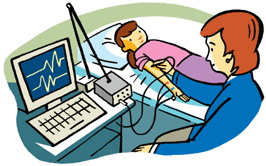The electromyogram (e-leck-tro-MY-o-gram) or EMG laboratory examination is a test that tells the doctor about your child’s nerve and muscle function. This test is often done when a child has weakness in his or her arms or legs. It helps doctors figure out if the weakness is due to a muscle condition or a nerve disorder. Information from the exam will help the doctor diagnose your child’s condition, which is the first step toward starting treatment.
The EMG laboratory exam includes an EMG needle test and nerve conduction tests.
- The EMG needle test uses small needles inserted into certain muscles to record muscle activity. Inserting the needles feels like sharp pinpricks.
- Nerve conduction tests use disks on the skin to record how nerves and muscles react to mild electrical impulses.
- Both the EMG needle test and nerve conduction tests are safe.










